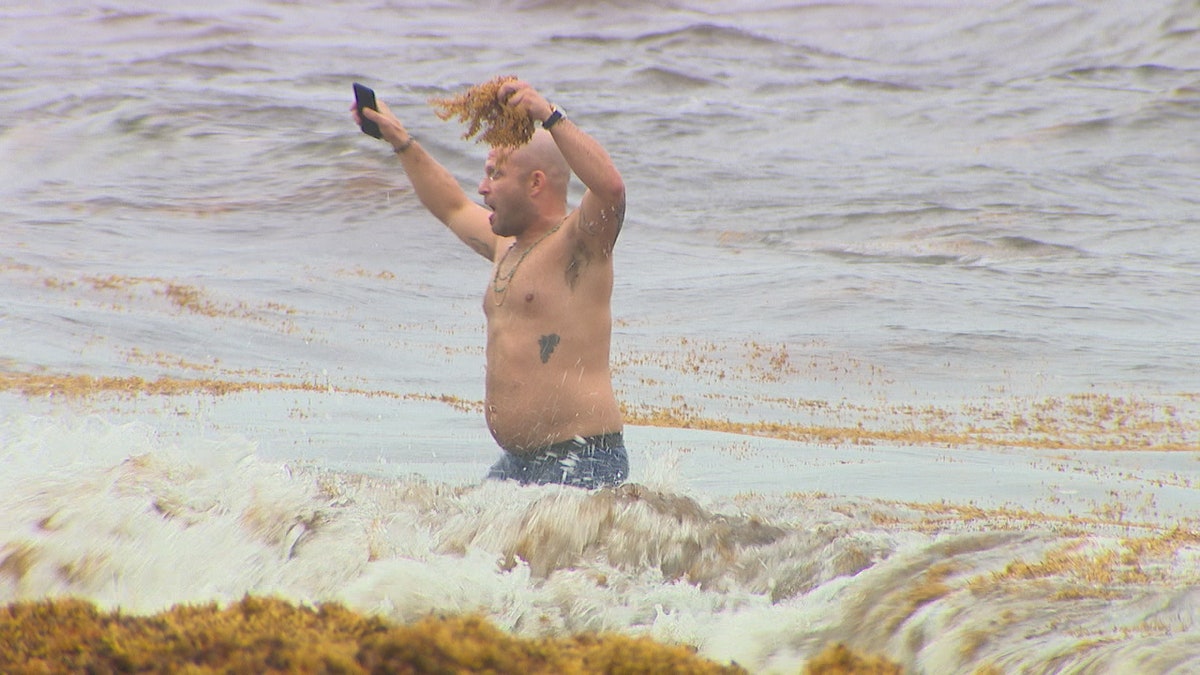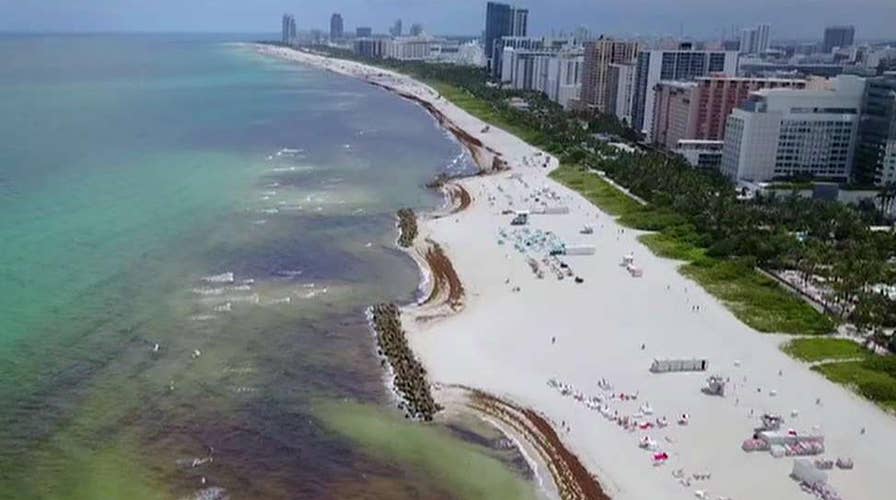Florida beaches covered in rotting seaweed as unprecedented amounts wash onshore
Miami Dade County is spending hundreds of thousands of dollars to remove stinking mountains of seaweed from the South Florida coastline; Phil Keating reports from Miami Beach.
MIAMI BEACH – For the Ayers family, it should have been a picture-perfect day on the beach. But then they smelled it, and they saw the mountains of seagrass.
"We came from Naples yesterday, and we were shocked when we walked on the beach. We had no idea, and it is just full of weed!" said Christie Ayers, a mother of two on vacation here.
Beds of smelly, rotting seaweed are washing up on the shore of South Florida in record amounts. It’s decorating the sand with brown carpets, twisting and tangling around the ankles of beach visitors, and keeping a lot of folks at bay.
"This is terrible, but this is nature," said beach visitor Lubel Ivanov, a tourist from Dallas.
The recent seaweed invasion is alarming local officials who are concerned that it could impact its lucrative tourism industry, which is largely reliant on its sunny, and pristine, beaches.

Beds of smelly, rotting seaweed are washing up on the shore in record amounts. Decorating the sand with brown carpets, twisting and tangling around the ankles of beach visitors. (Elina Shirazi)
While the algae is not necessarily toxic to humans, it is proving to be a giant nuisance for the 16 million tourists who visit each year — and who spend nearly $30 billion in the process. And tourism officials are wondering: Will tourists still come if they can't visit the beaches?
FLORIDA WOMAN RECOVERING FROM FLESH-EATING BACTERIA INFECTION AS DOCTOR WARNS CASES LIKELY TO RISE
"Well, it's a challenge and we're going to have to deal with it," Miami Beach Mayor Dan Gelber said. "We're Miami Beach, so it's important for our residents and for visitors that we take care of it, and we are going to."
Miami-Dade County officials may now have to pay millions of dollars a year in beach cleanup costs to try and save the tourism industry. In June, county officials gave a presentation estimating that removing the seaweed would cost $35 to $45 milllion a year.
Since the end of last week, cleanup crews in South Florida have been targeting areas of the beach with the biggest buildup of the sargassum seaweed. They are using dump trucks and bulldozers to scoop it all up and haul it out of the sand. According to Miami-Dade County officials, crews arrive early in the morning and finish up by roughly 10:30 a.m. before the beach visitors arrive.
Around that time, South Beach looks like a construction zone, with bulldozers surrounding the shore, doing their work right alongside tourists and residents getting in the water. The Miami-Dade County Parks, Recreation and Open Spaces Department said it is removing the seaweed and transporting it to a landfill.

The Miami-Dade County Parks, Recreation and Open Spaces Department says it is removing the seaweed and transporting it to a landfill. (Elina Shirazi)
The seaweed is also proving to be a rubbish trap, collecting trash, flies, and whatever else washes up.
Scientists say this issue has been ongoing since about 2011, and they say we are at the peak of the problem now. Beyond Florida, the putrid plants are littering beaches in three other states: Texas, Louisiana, and South Carolina, along with countries like Mexico and Barbados.
GIANT WOODEN CROSS THAT WASHED UP ON FLORIDA BEACH DRAWS CROWDS
Marine scientists said the seaweed is not harmful but it is quite unpleasant.
"This is not a toxic algae, but when there’s large amounts of it, it smells bad … it looks kind of like a leftover food with too much soy sauce on it. Big rotting piles can emit a gas called hydrogen sulfide that can actually be irritating and somewhat toxic to humans," said James Douglass, a marine scientist with the Florida Gulf Coast University.
From a skyline view, visitors can see how much the seaweed is choking the shores. Scientists put the blame on things like pollution, rising ocean temperatures, amazon deforestation, increased agriculture and the use of fertilizers.

Scientists say this issue has been ongoing since about 2011, and they say we are at the peak of the problem now. (Elina Shirazi)
"We have a lot of nutrients coming down the Amazon River causing deforestation, and that is causing the sargassum seaweed to bloom, and it is coming around the Caribbean. Then the Gulf Stream brings it here, winds blowing it on shore, and now we have this mess," said Steve Leatherman, a Florida International University professor of environmental studies who calls himself "Dr. Beach."
CLICK HERE TO GET THE FOX NEWS APP
He said it's not only a nuisance — it's also harming wildlife.
"Turtles get underneath, it's so thick, you know, six feet thick under the water, they can't find a way out, they drown," he said. "Marine life, and also the fish, are dying because it absorbs the oxygen as it rots. There is no oxygen and the fish die."

Tourists can't help but notice the massive amounts of seaweed in the water. This visitor was throwing it around, taking pictures with the slimy algae. (Elina Shirazi)
Researchers say the seaweed may be here to stay.
"The future is, we are going to have a lot more sargassum like we've never had it before. We've always had some on this beach … but now, with this massive amount, guys are bringing heavy equipment out here or else put booms out there ... something to intercept it before it gets here," Leatherman said.
One thing most people can agree on: Residents and tourists visiting Miami Beach hope to see their nice clean beach again — as soon as possible.





















